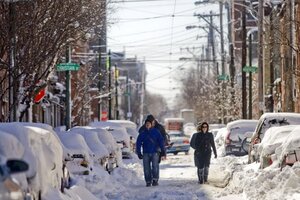Snowfall in the East busting records, and more is on the way
Back-to-back storms have shattered snowfall records in many cities, but don't put away your shovels just yet. Forecasters are predicting more snow next week.

A group of people walk up the middle of 12th Street in Philadelphia Thurs., Feb. 11, after the record-breaking blizzard that dumped more than a foot of snow across the state.
Jessica Kourkounis/AP
Winter’s not even over, but it’s already a season for the record books. Back-to-back storms shattered snowfall records in at least a dozen cities, including Philadelphia, Baltimore, and Washington.
Baltimore led the pack, breaking its record by the largest margin. Its seasonal snowfall total as of Thursday early morning was 79.9 inches, according to Marcie Katcher, spokeswoman for the National Weather Service. Its previous record was 62.5 inches, set in 1995-96.
Washington crushed its 121-year snowfall record Wednesday, with 55.9 inches measured at Reagan National Airport, according to the National Oceanic and Atmospheric Administration. It barely squeaked by, though. Its previous record was 54.4 inches.
Philadelphia also made history with its 71.6 inches. Its previous record was 65.5 inches, set in 1996.
Wilmington, Del., and Atlantic City, N.J., also broke records, with 66.7 and 50.1 inches, respectively.
“It’s hard to find anything in the history books of these types of storms back to back,” said National Weather Service meteorologist Stephen Konarik, in an interview with WBUR Boston.
Records likely to be broken again
And, says Ms. Katcher, of the National Weather Service, records will probably be broken again because it continues to snow in many areas.
The abnormally active snow season is due to a specific weather pattern that continues to beat down on the Mid-Atlantic, says Katcher.
“The reason we’re having an active weather pattern is because a strong jet stream is dropping cold air down from Canada and it’s mixing with warm, moist air coming up from the Pacific,” she says. “These two ingredients are causing an intense storm season across much of the East coast.”
“The storms have also tracked a little lower [south] than they traditionally have,” she adds.
The snow totals are so large because of the cumulative effects of several storms, according to the National Weather Service.
The two storms, on Feb. 5 and Feb. 10, dropped more than 2 feet of snow in parts of Maryland and over a foot in much of the Mid-Atlantic, according to the National Weather Service. Many areas saw wind gusts over 40 miles per hour, creating blizzard conditions that snarled traffic and left tens of thousands of homes and businesses along the east coast without power.
“[The storms] definitely had an impact throughout the region on transportation and commerce,” says Katcher.
Washington pretty much shut down
Wednesday’s storm shut down the federal government for a fourth straight day, the first time in history it’s been closed four days in a row. Some 230,000 federal workers in Washington have been off since Friday afternoon, when the first storm started. Congress has scrapped hearings for the rest of the week. Officials estimate the federal government closing is costing taxpayers $100 million per day.
In Baltimore, the storm shut down schools, businesses, highways, and public transit.
The National Weather Service reports that at least 5,000 flights across the US have been cancelled.
And although reports suggest sales of shovels, road salt, groceries, and alcohol are up, airlines and department stores will likely post millions of dollars in lost revenue due to the storms. Dan Hess, CEO of Merchant Forecast, says the storm will knock department store sales by 10 to 25 percent.
And it’s not over, yet.
Forecasters are predicting more snow next week.
-----
Follow us on Twitter.
